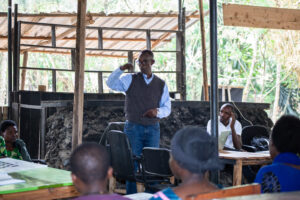In the farming communities of northern Rwanda and southwestern Uganda, farmers are forced to choose between the quick but short-lived gains of artificial fertilisers and regenerative agriculture practices for sustainable production.
For many, the former is a necessary evil that doesn’t particularly guarantee best results in the long run but secures a meal for the present.
The increasing population against the available arable land and the devastating effects of climate change have only exacerbated the limitations facing the agriculture sector in both countries.
According to Dr Richard Kanyarukiga – a professor at the College of Agriculture, Animal Sciences and Veterinary Medicine, University of Rwanda – these issues not only threaten food security but also put the health of humans and wildlife, especially the mountain gorillas in the Virunga Massif, at risk.
“About three decades ago, the global concerns, especially in the developing countries, had been centred on food security – people having enough food to eat. A few years later, we realised that equal attention must be paid to nutritional and safety aspects. Climate change threatens both and that’s why we now are adopting holistic, climate-smart methods for sustainable agriculture,” Dr Kanyarukiga notes.
He made these observations during a climate-smart agriculture cross-border workshop that was recently held in Musanze, northern Rwanda, organised by Red Rocks Rwanda and Nature Guardian and supported by DANIDA Fellowship Centre and the Ministry of Foreign Affairs Denmark.
Dr Kanyarukiga notes that tackling the limitations in the sector require a multipronged approach that integrates food safety and security, climate-smart agriculture and sustainability strategies.
“For climate-smart agriculture in particular, we are looking at preparing for the possible effects of climate change on farming patterns so as to maximise productivity and prevent further deterioration of the environment,” he says.
He goes on: “It is important that our smallholder farmers are assisted to appreciate the value of moving forward in a sustainable manner. They must look at optimising productivity of nutritive produce that takes care of the environment, the people and also fetches market on the commercial front.”

Harnessing Agricultural Extension Services
According to Dr Kanyarukiga, the best way to create sustainability in the agricultural sector is by equipping the stakeholders with knowledge, creating awareness on the existing issues and the available solutions.
Rwanda in particular has an agricultural extension system that caters to the needs of agriculturalists at every administrative level. Agronomists and veterinary consultants are readily available to help farmers make better decisions.
“Our job here today is to make the farmers aware of their rights to access an agronomist because that’s their job as public servants. In turn, we are also asking the agronomists to form cordial relationships with the farmers so that the lines of communication exit. Our smallholder farmers need to seek the expertise of the agronomists so that they know where to plant what or which vaccines to use for animals,” he said.

In Uganda, the National Agricultural Advisory Services (NAADS), a government agency, deals more with farmers’ cooperatives as regards supplying planting and livestock materials – and even agro-machinery.
Three farmers who spoke to Prime News in Kisoro, however, noted that NAADS sounds like a far-fetched solution because “it’s a rare to interact with the officials about issues of an ordinary farmer. That’s why workshops like these are more important because we get to have agronomists on ground, at no cost.”
Peter Iraguha, an agronomist in Kisoro, says educating farmers or responding to their needs is something he does out of goodwill.
“I am not paid to do this, but I also know that this knowledge I acquired is best used when shared. Our people here are dealing with land fragmentation and soil fertility decline. It’s my duty to teach them better farming methods like we just demonstrated on Irish potato planting,” Iraguha said.
Mr Iraguha was one of the facilitators at the second leg of the climate-smart cross-border workshop held in Gisozi, Kisoro.

Adopting Climate Smart Agriculture Practices
About 100 farmers who participated in both workshops had a field tour of the model gardens and were taken through climate-smart agriculture practices as demonstrated by facilitators.
The practices covered areas of soil, water management and crop management and integrated pest and disease control, among others.
The table below compiles the practices discussed and their purpose.
| Soil & Water Management | Crop Management | Integrated Pest and Disease Control | Agroforestry |
| Mulching to retain moisture in the soil, enhance the nutrients like humus, control erosion and weeds, and limit contact of pesticides with soil.
|
Seed selection for healthy crops and high yield. | Combining biological, physical, chemical and crop specific pest and disease management approaches for holistic control.
|
Use of multipurpose boundary trees such as bamboo. |
| Improved post-harvest handling and storage. | |||
| Composting and use of organic fertilisers to improve soil fertility while maintaining natural state. | Soil testing to determine the nutrients present or needed for proper variety selection. | Use of organic pesticides to reduce chemical effects, planting pest repellants as garden boundaries. | Planting Nitrogen-fixing trees in the gardens such as legumes. |
| Use of improved irrigation systems such as drip irrigation. | Use of new, more climate change tolerant crop varieties. | Physical monitoring for early pest and disease management. | Incorporating fruit trees to diversify production such as avocados. |
| Contour planting and terracing to prevent erosion and trap runoff water. | Intercropping and crop rotation to maximise pest control and nitrogen fixing in the soil. |
Organic way, the safer way
Farmers in southwestern Uganda and northern Rwanda share not only common problems in the agricultural sector but also the fact that their operations affect, in one way another, the existence of the endangered mountain gorillas that call the Virunga Mountains home.
Gaspard Nzayisenga, a veterinarian working with the Wildlife Conservation Initiative in Rwanda, says agriculture and conservation are intertwined and in the Virunga area, so practicing caution with what farmers do in crop production or animal keeping is very vital.
“We need to be mindful of what the agricultural inputs we use contain and how they affect the environment. Whatever we put in the environment directly affects wildlife – animal health and plant health, gorillas included, and all other species with which they share the habitat. We also need to understand that the negative impacts of agriculture on the environment affect us, humans, in our communities,” Nzayisenga said.
He added: “If we use pesticides that contain harmful chemicals, yes, we are killing the pests but we are also killing the other important animal species that are needed for the wellbeing of the ecosystem. These chemicals also accumulate in the soil, leach into the water bodies and we end up consuming them too.”

He urged farmers to consider the greater impact of the agricultural inputs, especially the non-organic elements, before using them in the gardens.
Substituting artificial fertilisers and chemical pesticides with the organic options, he emphasised, is the safer way for the wellbeing of the ecosystem.

